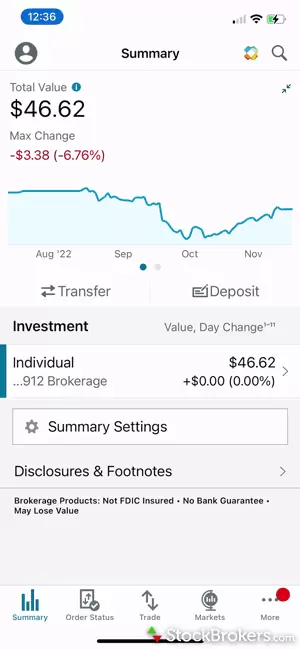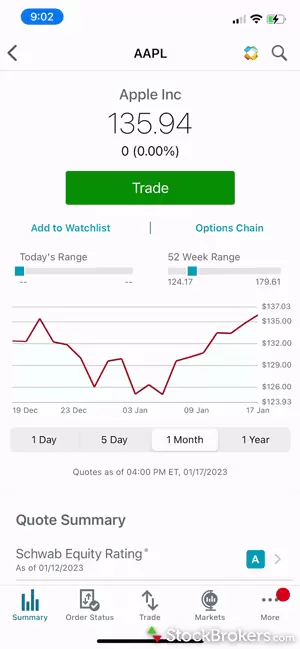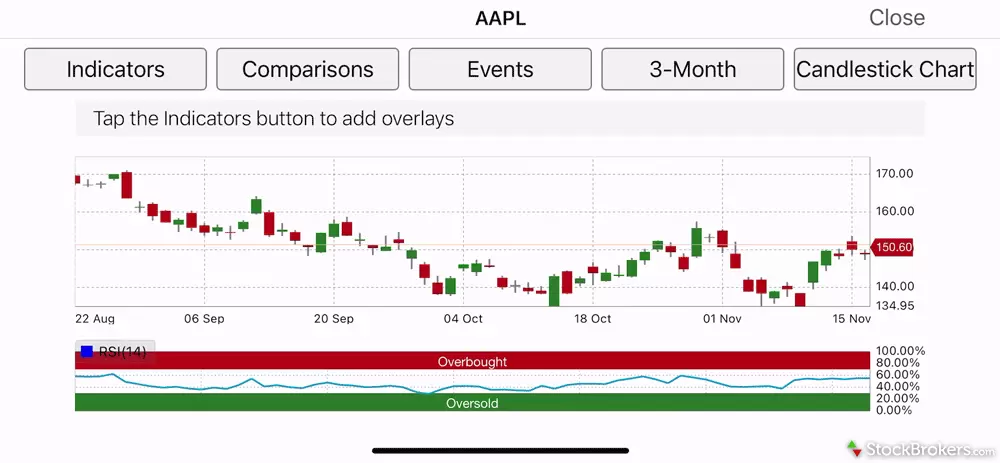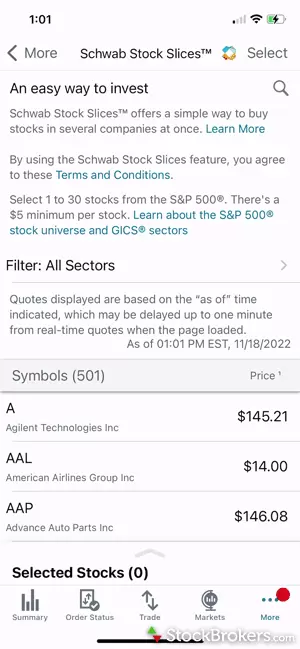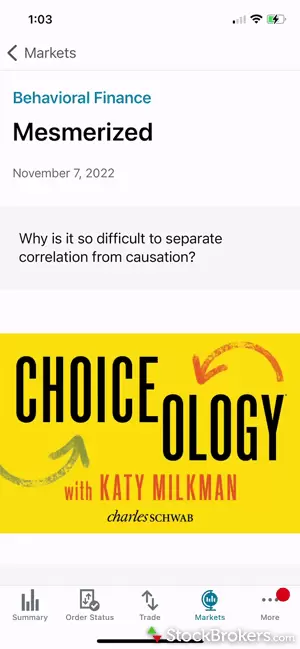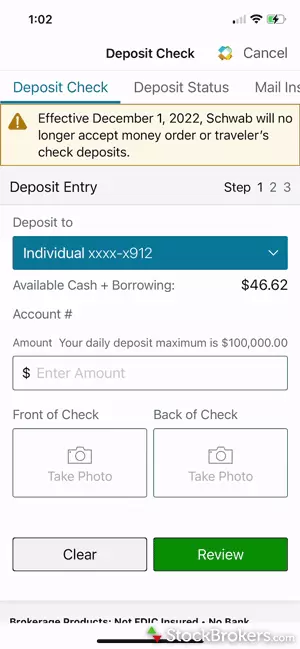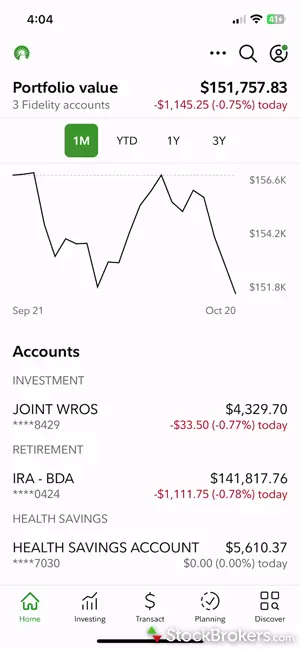Winners Summary
Best broker for day traders - Interactive Brokers
| Company |
Minimum Deposit |
Stock Trades |
Options (Per Contract) |
 Interactive Brokers Interactive Brokers
|
$0.00 |
$0.00 |
$0.65 |
Why Interactive Brokers is the best brokerage firm for day traders: Interactive Brokers (IBKR) delivers institutional-grade trading tools, advanced order types, and some of the lowest margin rates in the industry. Its powerful Trader Workstation (TWS) platform, direct market access, and algo trading capabilities give active traders the tools they need to trade efficiently and manage risk in real time. With deep customization and advanced features, IBKR is my top choice for serious day traders in 2025.
Desktop experience: Trader Workstation is at the core of IBKR’s offering, providing real-time monitoring, customizable charting, and complex order types like bracket and conditional orders. Being able to bracket a trade immediately, placing stop-loss and profit targets at trade execution, is essential for deploying an immediate exit strategy. Algo trading is also integrated, allowing for automated strategies that reduce the need for manual order placement. Tools like Risk Navigator and Market Scanner help traders identify opportunities and manage risk in real time, ensuring you have visibility into your entire portfolio and drilling down as granular as your portfolio's beta or even your sharp ratio.
Mobile experience: IBKR Mobile brings pro-level trading to your phone, offering nearly the full web experience. The trade ticket is one of the most advanced I’ve seen on mobile, allowing for detailed order customization and complex options strategies. Options traders finally get a seamless way to trade directly from the options chain, with a strategy wizard and analyzer providing all the key data points needed for informed decision-making. Charting includes over 90 indicators and syncs across devices, while watchlists support more than 50 custom fields, including valuation metrics like forward P/E ratio. Whether managing stock trades or complex options positions, IBKR Mobile delivers the depth and flexibility active traders demand.
Margin rates: On the margin front, IBKR has some of the lowest rates in the industry. But it’s not just the low rates that differentiate Interactive Brokers, it’s the visibility into your intraday balances as well. IBKR clearly delineates margin from non-margin balances, shows the margin requirement of your trade upon order entry, and even calculates the post-trade impact, ensuring you always understand your exposure before clicking that submit trade button.
For traders who need institutional-grade order tickets, deep customization, and low-cost margin, IBKR is the best brokerage for active trading and day traders in 2025. Visit my full Interactive Brokers review to discover more about all of its features and pricing.
IBKR Trader Workstation (TWS) gallery
IBKR mobile app gallery
Best desktop platform for day trading - Charles Schwab
| Company |
Minimum Deposit |
Stock Trades |
Options (Per Contract) |
 Charles Schwab Charles Schwab
|
$0.00 |
$0.00 |
$0.65 |
Why Charles Schwab has the best desktop platform for day trading: From my perspective, Charles Schwab’s thinkorswim platform is one of the best tools a day trader can have. It’s one of my favorite desktop platforms for monitoring the markets, offering powerful charting, integrated FRED data, options analysis tools, and even earnings analysis.
Top-of-the-line charting: Let’s start with charting. Thinkorswim provides hundreds of technical indicators, drawing tools, and fully customizable chart layouts, so you can set up your screens exactly how you trade. I’ve tested plenty of platforms, and switching between multiple charts on thinkorswim is smooth and glitch-free, even when streaming large amounts of data.
Advanced order types: Execution matters just as much. Advanced order types like conditional and bracket orders let you set up take-profit and stop-loss points immediately, helping you stay disciplined. I also love the one-click order entry and customizable trade tickets—when speed matters, this kind of intuitive trade execution makes all the difference.
Best for research: Then there’s real-time data and news. Thinkorswim integrates live streaming via the Schwab Network, economic updates, and price alerts, keeping everything you need in one place. And for anyone fine-tuning their strategy, paper trading is available, making it easy to test trades without risking real capital. The combination of depth, usability, and integration of these resources scored Charles Schwab our award for #1 Research.
Margin: Finally, margin display is another area where Schwab gets it right. Margin is clearly kept separate from non-margin balances while margin requirements and post-trade impact to available margin is displayed before trade execution, which is essential when managing risk.
Between the powerful tools, complex order tickets, and real-time insights, Schwab’s thinkorswim platform is a go-to for serious active traders and is, in my experience, one of the best on the market. Explore more about its offering and the award-winning thinkorswim platform at my comprehensive review of Charles Schwab.
Charles Schwab desktop and web gallery
Charles Schwab mobile app gallery
Best platform for beginner day traders - Fidelity
| Company |
Minimum Deposit |
Stock Trades |
Options (Per Contract) |
 Fidelity Fidelity
|
$0.00 |
$0.00 |
$0.65 |
Why Fidelity is the best broker for first-time day trading: Fidelity strikes the perfect balance between power and accessibility, making it ideal for traders learning the ropes. Its Active Trader Pro platform simplifies risk management with visual bracket orders, while tools like the Margin Calculator for hypothetical purchases help investors understand their exposure before placing trades. Add in top-tier trader support, real-time education, and Fidelity’s commitment to execution quality with no payment for order flow, and it’s the best starting point for new day traders.
Platform and order ticket: Fidelity’s Active Trader Pro (ATP) platform is a go-to choice for active traders who want advanced indicators, technical analysis tools, and seamless trade execution. Let’s start with order execution. Fidelity pioneered the visual bracket order, making it simple to set up buy limit order triggers with stop-loss and take-profit levels in a single step. This streamlines risk management and trade automation, helping traders stay disciplined without extra steps.
Margin: Margin visibility is another standout feature. Fidelity clearly displays margin balances upon order entry and on the positions page, so you always know where you stand. Their Margin Calculator goes even further, allowing you to model hypothetical trades, understand their margin impact on your balances and buying power, and even factor in the specific margin requirements for your account (like concentration increases).
Support and education: What really sets Fidelity apart for me is the support. Fidelity’s Active Trader Strategy Desk offers live events and training on advanced trading and market concepts, helping traders master the platform and refine their strategies. They even provide education on trading violations, ensuring you understand rules like good faith violations, day trading rules, and margin requirements before they become a costly mistake.
No payment for order flow: Finally, Fidelity is one of the few brokerage firms that does not accept payment for order flow (PFOF). This commitment to order execution quality means you’re more likely to get better fills and price improvement.
For traders who want a powerful platform, real support, and superior execution, Fidelity delivers. Discover more about its wealth of features and tools at my in-depth Fidelity review.
Fidelity desktop gallery
Fidelity mobile app gallery
Day trading platforms comparison
Fees comparison
Margin rates comparison
Here's a comparison table of the margin rates charged by the best trading platforms for day trading.
|
Feature |
 Interactive Brokers Interactive Brokers
|
 Charles Schwab Charles Schwab
|
 Fidelity Fidelity
|
 E*TRADE E*TRADE
|
 TradeStation TradeStation
|
|
Margin Rate Under $25,000
info
|
7.33%
info |
13.575%
|
13.075%
|
14.2%
info |
13.0%
|
|
Margin Rate $25,000 to $49,999.99
info
|
7.33%
info |
13.075%
|
12.575%
|
13.7%
|
13.0%
|
|
Margin Rate $50,000 to $99,999.99
info
|
7.33%
info |
12.125%
|
12.125%
|
13.2%
|
12.5%
|
|
Margin Rate $100,000 to $249,999.99
info
|
7.33%
info |
12.075%
|
11.575%
|
12.7%
|
12.0%
|
|
Margin Rate $250,000 to $499,999.99
info
|
7.33%
info |
11.825%
|
11.325%
|
12.2%
|
12.0%
|
|
Margin Rate $500,000 to $999,999.99
info
|
7.33%
info |
Varies
info |
9.00%
|
Varies
info |
7.5%
info |
|
Margin Rate Above $1,000,000
info
|
7.33%
info |
Varies
info |
8.75%
|
Varies
info |
7.5%
info |
FAQs
What are the basics of day trading?
Day trading is the practice of buying and selling financial instruments — like stocks, options, or futures — within the same trading day. The goal is to capitalize on short-term price movements rather than holding positions overnight.
Day traders rely on real-time market data, technical analysis, and rapid trade execution to make quick, informed decisions. They often use margin accounts to increase buying power and execute strategies like scalping, momentum trading, and breakout trading.
ruleOne key rule to know
The Pattern Day Trader (PDT) rule is important to be aware of when using margin. In the U.S., traders with less than $25,000 in a margin account are limited to three day trades in a rolling five-day period. If you exceed this, your account may be restricted unless you meet the minimum balance requirement. This is true across all brokerage firms.
Successful day trading can be quite difficult. It requires a deep understanding of market trends, risk management, and discipline, as well as a brokerage platform with fast execution, advanced charting, and real-time data. For a run-down on the many reasons you might not want to day trade, read the take from our founder Blain Reinkensmeyer on his 10 reasons to avoid day trading.
What is margin?
Margin is a form of leverage. Margin accounts let traders use their portfolios as collateral for loans, which they can use to buy more investments.
A margin account gives you access to this borrowing power, but it comes with specific requirements:
- Initial Margin – The percentage of a trade’s total value that you must fund with your own cash before borrowing. This is the Fed funds requirement, or Reg T, and is usually 50%.
- Maintenance Margin – The minimum equity you must maintain in your account to keep a margin position open. If your balance falls below this level, you’ll receive a margin call, requiring you to deposit more funds or close positions. The excess is what drives your buying power. This is set by your brokerage firm and is generally 30% and sometimes referred to as “house requirements”.
- Margin Interest – Since you’re borrowing money, brokers charge interest on margin loans, which varies by firm and loan size. Usually, margin interest is accrued on borrowed funds held overnight.
Margin is widely used in day trading, options trading, and short selling for the flexibility it can offer, but it comes with higher risk. If the market moves against you, losses can exceed your initial investment. That’s why understanding margin requirements, risk exposure, and how margin impacts your account is crucial before using it.
What are some tips and resources to get started day trading?
Learn the fundamentals: Before placing a single trade, make sure you understand:
- Market mechanics – How and why stocks, options, and futures move
- Technical analysis – Chart patterns, indicators, and support/resistance levels
- Order types – Market orders, limit orders, stop-loss, and bracket orders
- Risk management – Position sizing, stop-loss placement, and managing drawdowns
Interactive Brokers and Charles Schwab have extensive courses and resources to learn and keep up with the markets.
Pick the right brokerage and platform: Day trading requires precision and skill backed by an advanced trading platform with day trading software. Here are my picks:
- Interactive Brokers (Trader Workstation) – Best for low-margin rates and advanced execution
- Charles Schwab (thinkorswim) – Best for technical analysis and customization
- Fidelity (Active Trader Pro) – Best for execution quality and trader support
Practice with paper trading: Most brokers offer virtual trading accounts where you can test strategies without risking real money. Use this time to refine your trade execution and get comfortable with your platform.
Track your trades and adjust: The best traders review their trades regularly to identify mistakes and improve. Use a trading journal to track entry and exit points, reasons for entering and exiting the trades, and mistakes or lessons learned. Your goal is to refine a disciplined approach.
Manage your risk and focus on risk versus reward: Day trading is risky, and protecting your capital is just as important as making profitable trades. Follow the 1% rule (never risk more than 1% of your account on a single trade) and use stop-losses religiously. Using higher percentages of your portfolio will result in an impossible scenario to overcome if you end up with a loss — and you eventually will have losses while day trading.
For more tips on how to get started along with a deep dive into the different strategies day traders employ, head on over to our comprehensive guide on how to day trade.
Can you day trade on multiple platforms?
Yes. It’s common for day traders to have multiple brokerage accounts and use several trading platforms simultaneously. A trader might prefer the chart analysis tools of one broker but prefer to trade options at another. It’s also a good idea to have a backup account open and at the ready in case a preferred broker suffers a data glitch or crash.
What is the fastest day trading platform and software?
The fastest day trading platform will be found among TradeStation, tastytrade, Charles Schwab's thinkorswim, Interactive Brokers' Trader Workstation (TWS), and Webull because they are desktop-based. With a desktop trading platform, the base code runs locally on your computer, maximizing speed. That said, web-based trading platforms built with modern code can match desktop platforms in overall speed. Day trading software aside, the most common bottleneck for any trading platform is the internet connection.
What is the best app for day trading?
The best app for day trading in 2025 is Interactive Brokers’ trading app as our rigorous testing proves. Based on extensive hands-on evaluation, IBKR’s mobile platform stands out for its advanced tools, in-depth order tickets and trade executions, and seamless usability which are all critical factors for active traders when away from their desktop computers. While many other brokers offer solid mobile platforms, IBKR is simply the most complete app for active traders who need institutional-grade tools on their phone.
What day trading platform is best for first-time day traders?
For beginner day traders, Fidelity is a great choice. The platform is intuitive, easy to customize, and designed to help new traders navigate the fast-paced world of active trading.
Fidelity stands out for its live trader support. The Active Trader Strategy Desk offers real-time coaching and educational events, making it easier to learn advanced strategies. The platform also helps new traders understand trading violations, margin rules, and risk management before costly mistakes happen.
Paper trading allows beginners to test strategies without risking real capital. Fidelity also prioritizes execution quality by not accepting payment for order flow (PFOF), which can lead to better price improvement. For new traders who need guidance, Fidelity offers the best mix of education, support, and technology.
Our testing
Why you should trust us
Jessica Inskip is Director of Investor Research at StockBrokers.com, bringing 15 years of experience in brokerage and trading strategy. A former FINRA-licensed rep, she held Series 7, 63, 66, and 4 licenses. Jessica focuses on investor education and brokerage industry research, appears regularly on CNBC, Bloomberg, The Schwab Network, Fox Business, and Yahoo! Finance, and hosts the Market MakeHer podcast.
Blain Reinkensmeyer, co-founder of StockBrokers.com, has been investing and trading for over 25 years. After having placed over 2,000 trades in his late teens and early 20s, he became one of the first in digital media to review online brokerages. Today, Blain is widely respected as a leading expert on finance and investing, specifically the U.S. online brokerage industry. Blain has been quoted in The New York Times, The Wall Street Journal, Forbes, and Fast Company, among others. Blain created the original scoring rubrics for StockBrokers.com and oversees all testing and rating methodologies.
How we tested
- We used our own brokerage accounts for testing.
- We collected thousands of data points across the brokers we review.
- We tested each online broker's website, desktop platforms, and mobile app, where applicable.
- We maintained strict editorial independence; brokers cannot pay for inclusion or a higher rating.
Our research team meticulously collected data on every feature of importance to a wide range of customer profiles, including beginners, casual investors, passive investors, and active traders. We carefully track variables like margin rates, trading costs, fees, and platform features and use them to help rate brokers across a range of categories measuring ease of use, range of investments, research, education, and more.
At StockBrokers.com, our reviewers use a variety of computing devices to evaluate platforms and tools. Our reviews and data collection were conducted using the following devices: iPhone SE running iOS 17.5.1, MacBook Pro M1 with 8 GB RAM running the current MacOS, and a Dell Vostro 5402 laptop i5 with 8 GB RAM running Windows 11 Pro.
Each broker was evaluated and scored on over 200 different variables across seven key categories: Range of Investments, Platforms & Tools, Research, Mobile Trading, Education, Ease of Use, and Overall. Learn more about how we test.
Trading platforms tested
We tested 16 online trading platforms for this guide:


























































